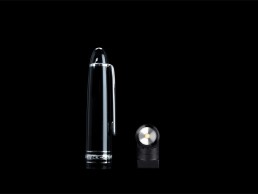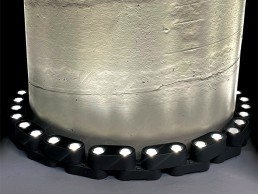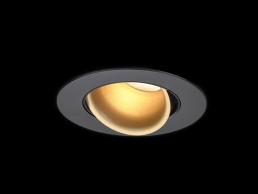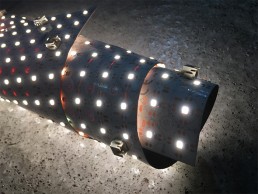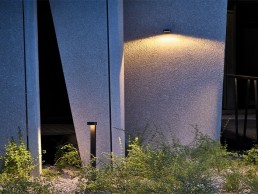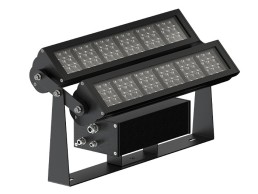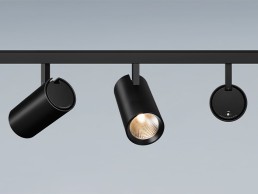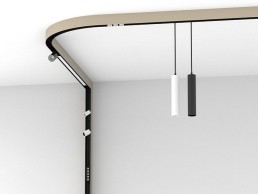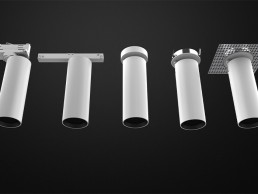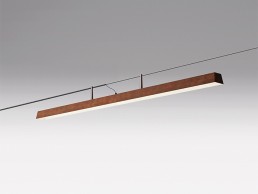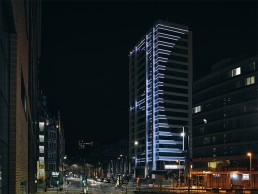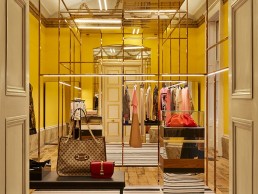John Cullen Lighting Vorsa Dot
Bring focus to what matters with the smallest track-mounted luminaire on the market – the Vorsa Dot. With a choice of flood or spot luminaires, multiple different optics and five different snoots, it allows your lighting to be as tailored as your display. An innovative proprietary track with different mounting options offers maximum control with independent dimming levels. The Dot delivers a powerful 65Lm along with a CRI of 98.
Bright Special Lighting Regio Flex LED
The Regio Flex LED is the latest entry into Bright Special Lighting’s high-quality LED lights. The wallwasher has a smart design, allowing the fixtures to be hidden, while ensuring that walls and ceilings are properly illuminated with options of optical lens’ from 5-60. With a high pressure casting aluminium body, low wattage, IP65 rating and uniform lighting, designers can create indirect lighting effects, integrate mood lighting and bring the night to life.
LightGraphix LD792
LightGraphix has launched four new downlights - LD780, LD782, LD790, and LD792 - with single colour, two-tone, fixed and adjustable options, rated IP65 for interior, exterior and marine applications. Bezel diameters start at 46mm, achieving an excellent size to output ratio delivering over 400lm. Colour temperatures range between 2200K-5000K and beam angles include several medium and a super tight 10° narrow. A single deep recessed optic ensures ultra-low glare, superior beam shape and no multiple shadows.
Applelec Auragami
Helping to bridge the gap for achieving complex illuminated schemes, Auragami from Applelec is an extremely flexible and versatile backlighting panel. Delivering flawless illumination to sharp edge designs, Auragami can be shaped at an impressive 90° angle or wrapped around columns and curved surfaces. Utilising tight pitch, powerful LEDs, Auragami is the ideal solution for producing luminous backlighting for particularly dense surface material of up to 20mm depths.
ewo if round
A striking join at the neck of this luminaire accommodates ewo’s A–Series optical system, opening ewo’s entire light-shaping technology toolbox for bespoke lighting configurations.
Through the if round, ewo strives to shape and target light to improve the quality of cityscapes and all manner of architecture, for every imaginable lighting design freedom.
Ligman KWH Range
A unique linear shape, rounded profile luminaire with surface-mounting bracket, and robust, tiltable body, offered in different lengths means the KWH range provides multiple optical and professional lighting solutions for building, area and façade lighting. Suitable for installation in narrow spaces, both single and twin modules can be tilted up to 180°. Complete with a remote-control gear box attached to the bracket to reduce heat from the body, it covers RGBW and RGBTW (RGB Tunable White 2700K - 6500K) systems via RDM, DMX systems.
mawa design seventies 70's plus
Track spotlight for highly professional application in museum settings, the seventies 70’s plus is the sequel to its predecessor, the seventies 70’s series. It incorporates two LED modules, beam angles (11° to 52°) and power classes (10W to 37W) that are modularly configurable for special lighting requirements. It is suitable for museums, regarding excellent colour rendering and minimisation of potential light damage with respect to preventative conservation.
Petridis Storm
Storm is a 24V DC low voltage aluminium profile for tracking lights with smart magnet technology.
It is an ideal solution for small showcases, homes, rest areas, museums, hotels, exhibition halls and generally for many decorative and architectural projects
Lucent TubeLED Mini HO
The newest addition to the Lucent TubeLED range, the TubeLED Mini HO (High Output) is designed to deliver maximum performance whilst maintaining the Mini’s small form and flexibility. The fixture is idea for retail and gallery applications with its high performance and architectural aesthetic form. The fixture incorporates an integral driver in the tubular body with various dimming protocols negating the need for a separate driver housing resulting in its clean form.
Linea Light Group Lingotto
Lingotto is a new solution particularly suited to lighting up pergolas, exterior walls, cellars and basements. Perfect for outdoor environments, thanks to the polyurethane resin diffuser with an IP65-rating, the fixture is weather and humidity resistant, characterised by a body lamp in AISI 304 stainless steel. Lingotto is available in black and dark brown finishes in various suspension wall and ceiling versions
111 Piccadilly, UK
A landmark building for travellers arriving into the UK city of Manchester, 111 Piccadilly has been given a facelift with a new, dynamic lighting scheme, designed by local firm Artin Light.
Standing on Station Approach, the main thoroughfare in and out of the city of Manchester for travellers into Piccadilly Station, is 111 Piccadilly. Formerly known as Rodwell House, the high-rise development, owned by Bruntwood Works, was first opened in 1965, and has long been recognised as one of the first buildings commuters and visitors see on arriving in the city.
The building, defined by its sharp, grid-like geometry, has recently been given a new lease of life thanks to a dynamic new light art installation from Artin Light.
Brought in by Bruntwood Works via a connection with architects 3D Reid, Artin Light was appointed to transform and enhance the building’s architecture, bringing a sense of movement and vibrancy to its vertical and horizontal lines and turning it into a defining landmark for the city.
“Bruntwood Works was looking at the external lighting design, and they felt that there was a big opportunity to do something out of the norm, particularly as the building is fundamental in terms of the gateway into the city,” explained Luke Artingstall, Director of Artin Light.
“I met with them and pitched a number of design ideas, trying to think out of the box in terms of what we could do with the building to show the potential that it has and what we could do with the lighting, the main body of which was focused on how we can illuminate it to have an impact and make it a key gateway building.”
With Bruntwood Works already open to the idea of a creative lighting scheme for the building’s façade, this opened up a host of possibilities for Artingstall, ranging from traditional architectural lighting, through to more intricate and dynamic ideas, all centred around adding something awe-inspiring to this busy area of Manchester.
“I wanted to do something a little bit more unusual, something more dynamic that wouldn’t necessarily be static over time,” he added. “The design team’s initial thoughts, prior to Artin Light being appointed, were to uplight the building and focus on the vertical aspect of the tower, whereas the way that I looked at it was to look at both axes. If you strip back the geometry of the tower, it’s very simple and clean, so we looked at the vertical aspects and how we can play on the height of the building itself, and then also flipped that on its head, using the strong geometry of the horizontals to slice and intersect it in a way which is slightly different to what they first considered.
“Once the client and design team considered the way light could be used on the building in a more dynamic way, their aspirations for what we could achieve grew from there.”
As such, Artingstall was able to develop the concept from a simple façade lighting scheme into something more artistic, that would alter the way the building was perceived.
“From that point onwards, it wasn’t about illuminating the building or creating an external façade scheme, it was about creating a digital art piece that we could use in a way that would completely transform the nature of the building and how it was visualised, where we could use light in a graphic format.
“Our vision was to blend fiction with reality, creating a range of bold, geometric, linear infused forms that would transition from one form to another. Each transition was meticulously designed to deliver smooth, natural animations that were inspired by several forms of movement: generative flow; wind and water, the natural movement of particles in the air; and architectural traffic, defining the transitions in vertical and horizontal movement.”
This concept saw Artingstall approach the building in a three-dimensional manner, using light in a pixelated format to create 3D forms and structures across each of its elevations, “using the angles of the buildings and the façades to create the perception that the building is transforming into different geometries, but using that as the backdrop to the darker sky and creating a contrast between the two.”
To help bring this dynamic concept to life, Artingstall worked with local specialist integrators Studiotech, who developed the lighting controls and content generator for the live data streaming element of the scheme, opting for Osram’s Ecue lighting control system. The system works on an open API format, which allows for live data, generated through specific hashtags on social media to be translated into specific visuals of light, mirrored across the façade in particle-based forms, essentially turning 111 Piccadilly into a canvas for one of the largest live data streaming visual artworks in the world.
“Studiotech also presented a number of digitally addressable products that we could potentially use to achieve our design requirements,” Artingstall added. “And the technology behind what is happening in the software and control of the pixels means that of the three kilometres of linear LED on the façade, we can control every 125mm of the actual LED profile.”
On a technical level, the content generated for the exterior lighting scheme is something that Artingstall believes is integral to its success. “The building has the potential to be beautiful, intricate and elegant if the visual content is developed in the right way. Therefore, it was fundamental that the design of the bespoke visual content animation sequences were developed for the building. We developed the concept and artistic vision and direction for the bespoke animations, which were then developed in collaboration with a specialist motion graphics studio.
“Creating buildings with dynamic installations is great, but if we don’t utilise it to the full potential, it doesn’t matter how good the actual architectural install is, or what kit is used. We could use a really basic product and visually make it look absolutely exceptional with the right content, so we put a fundamental importance on developing content that was completely unique and designed specifically for this building.”
Ed Vickery, Director at Studiotech, added: “We can use control systems to collaboratively create magic. A lot of the time, you spend lots of money delivering beautiful schemes but the content creation is forgotten.
“The content was the driver for this, and was how we could create something truly magical. The architecture is fairly simple, so the real skill and ingenuity and unique aspect comes from the marriage between our EQ programmer, and Luke, who is an artist. That’s what makes this a unique, game-changing scheme.”
Adding this new, dynamic lighting scheme to the existing framework of 111 Piccadilly was not without its challenges though, as Artingstall explained: “There were a number of key things that we had to consider when we were designing the original scheme, one of which was putting this dynamic lighting system onto an existing building that we couldn’t necessarily perforate. We had to look at ways in which we could feed power and data into each floor of the building, but do it in a way that is designed and didn’t look like it was stuck onto the building.”
Artingstall therefore looked to use a bespoke architectural trunking system that sat underneath the existing ledges above and below the windows – this trunking system incorporates the lighting fixtures, as well as the drivers and power supplies, and has been finished in the same colours as the window frames, so that they naturally blend into the building without changing its visual fabric.
“We also had to look at a surface-mounted channel system, which then went from the base of the building all the way to the top, and that was where we obviously got the power and data in terms of the control aspect of it. That was probably, without getting into the installation, the key technical element – getting the power and data to the fittings in a way that didn’t detract from the existing architecture.”
Throughout the design process, Artingstall was in close communication with Bruntwood Works, providing reassurances to the client about the benefits that such a vibrant, dynamic scheme could bring to the city.
“There were multiple conversations and meetings behind the approval of the scheme – one of the biggest things about it was the fact that no one has done this in Manchester to this scale. Particularly the client had never got into the realms of this level of complexity and impact with lighting.
“One of the turning points in the decision was when we presented the importance that this could have to the city centre, how it would potentially be perceived and what it gives back on a cultural level.
“I don’t necessarily see this as being a lighting design project, I see it as a celebration of creativity and digital art and doing something new and innovative for the city. For me, it’s a reflection of the city itself and the direction we’re going in.”
Vickery added: “111 Piccadilly is a special project for us. Not only does it stand as a real beacon of the power of lighting, it also represents a shift that we’re so excited to see happen. Our towns and cities are the lifeblood of our country, and we need them to be supported in order for them to thrive once again.
“Bruntwood Works showed real courage in investing a significant amount of money in this feature and I believe it will have paid off for them, They have brought such life and vibrancy to this area of Manchester, which will have a massively positive impact.
“Largely because of the sheer scale, the project has been incredibly complex to deliver, but equally rewarding. Our hope is that this will act as a catalyst for further investment in dynamic and architectural lighting; the power of which cannot be overstated.”
Alongside the exterior lighting scheme, Artin Light was also asked to develop the lighting for 111 Piccadilly’s interiors. Described by Artingstall as a “yin and yang scenario”, the mixed-use, co-working space needed a lighting solution atypical to what one might consider for a working environment.
“When I was approached to work on the project by 3D Reid, they wanted to speak to me about the interior because they wanted it to have a hospitality feel. As a client they’ve been moving a lot more in this direction with their interiors, the way the space is used and the way people socialise and use the space – it’s not just about work, it’s about creating a mini community.
“With my hospitality background, that was the original driver for getting involved, and the interior design was very much a different kettle of fish to what happened on the exterior, but I still think they complement each other well.”
With a focus on the hospitality aesthetic, the interior lighting is designed around the multiple uses of the space. Architectural fittings from Precision Lighting, Optelma, XAL, Lumenpulse and iGuzzini are offset by decorative elements from Marset, Santa & Cole and Northern Lights to create a warmer, more relaxed ambiance, while architectural scene settings allow for the lighting to transition from day to night, giving the client an added flexibility.
“Moving away from the traditional, commercial-based lighting design that we may have envisaged five to 10 years ago, it is very much about mood, warmth, contrast, highlight and making things pop, and that was just as exciting for me getting involved in the interior aspects as it was the exterior.”
Artingstall continued that he believes workspace design will develop into a more fluid, mixed-use format going forward. “People want to be more flexible now than they ever have been before,” he said. “There will be an increase in flexibility in terms of how people use spaces, and from that perspective, the lighting design needs to work around that. I feel historically, we probably overlit spaces, and I think we’re going in a different direction now, which is a good thing.
“We still need to adhere to some of those key aspects of lighting design for office and working environments, but then there’s also that element of looking at it a little bit differently and more un-traditionally, which is more driven by this hospitality feeling. It’s finding that balance between.”
After a tumultuous year working amid the Covid-19 pandemic, the project is finally complete and ready to share, and Artingstall believes that the new lighting for 111 Piccadilly – one of the first major projects for Artin Light – has turned the building into a landmark piece of art for the city of Manchester, and a celebration of its rich cultural and creative heritage.
“For a number of personal and professional reasons, this project has been a very emotional rollercoaster, so to see it complete and to see the reaction that the client has had, has been truly humbling.
“I know in terms of technology that has been used and the way things have been done, we’ve not necessarily created something new, but what it has done is shone a light on what we can do as creative designers and artists, particularly in the north. Manchester is such a vibrant community built on worldly characters. We’re so culturally rich, and creativity is a big part of that. We’re starting to see it celebrated, but we need to be pushing it more, and part of that is seeing digital art or illuminated buildings or murals.
“We wanted this to be a landmark project, representing Manchester’s vivid, colourful, and diverse culture and celebrating our city’s community and progression. I believe that 111 Piccadilly is much more than an external lighting design; it’s a symbol of progression in the creative arts, and how it can enrich our experiences in the cities we dwell, work, and socialise in.
“We need to continue to be positive and create inspiration in the world we live in and adapt this to the times of change and technology we are so accustomed to. Manchester is becoming a smart city pushing innovation, and 111 Piccadilly symbolises this movement.”
Brown's Brook Street, UK
At the new flagship Browns store on London’s Brook Street, Nulty has used light to enhance the luxury, boutique feel, creating a more tailored, comfortable retail destination for shoppers.
Luxury London retailer Browns has recently been added to the Nulty portfolio of beautiful retail lighting schemes with its newly completed flagship store on Brook Street in central London.
Browns has been a staple of British fashion for decades housing some of the greatest designer labels since its inception in 1970. This store is located in a Grade II* listed building that dates back to 1720. Each room has a unique identity, whether expressed through its architecture, size or colour scheme, and there is a mix of spatial and more intimate areas across the various floors.
Flexibility was key in the lighting design, and each room’s style had to be accounted for in a changeable approach that retains the identity of each space. The lighting design needed to adapt to these variations in style and so a mix of integrated lighting in hanging rails, shelving and niches were needed to illuminate the items on display. The lighting schemes can be altered throughout the spaces to recreate day or nighttime scenes, whilst spotlights and integrated direct and indirect light can be changed to accommodate various events or parties.
Evoking a modern twist within the plush historical setting was important to the concept. A breathtaking floor-to-ceiling light structure, by interior designers Dimorestudio, graces the atrium with neon-like LED light tubes from Encapsulite, creating a stunning focal point and contemporary ambience.
Martina Alagna, Lighting Designer at Nulty, sat down with arc to explain the historically conscious lighting scheme. With an already well-established portfolio of retail lighting projects, Nulty was chosen by Browns as the specialist lighting designer. “They wanted an expertise on lighting,” explained Alagna. “They knew that the interior designers are very forward thinking with their designs, but also very attached to traditions and the historical part of the design. But to bring everything up, Browns wanted a lighting designer, so we got involved straight away.”
During initial meetings, the team established a common design approach to the historic structure and understood that the lighting scheme was to be flexible according to the individual uses of each space. “From the first meetings together with Browns, they wanted to have a very flexible space, especially in areas like the Yellow Room and The Club on the third floor, where they have the VIP changing rooms. In these locations, customers have a completely different shopping experience from the other levels,” Alagna elaborates. “The Yellow Room, for example, turns into an event space, so it became a focal point for the entire project, and Browns really wanted this space to be changeable depending on the events that were happening,” she added.
Working within the historic building also brought challenges for lighting placements. During these initial meetings to determine the lighting scheme, it was important for the team to address the structural issues that would prevent certain luminaire placements. It was decided that the majority of fixtures would be integrated into the furnishings rather than permanently fixed to any architecture. Pieces such as LEDFlex’s Ultimo Neon, LED Linear’s Lyra Hyrda, DGA’s Mini Tini spots and Folio’s Tiny miniature LED profiles are integrated seamlessly within the furniture within the store.
“The feeling when you walk in is very different to a traditional store. The lighting is more tailored and specific to certain elements, whether it’s the merchandise or the architectural detail, or a historical part of the building. Whereas, usually if you walk into a different store it’s more focused on the merchandise and the architecture itself is not really part of it. This was absolutely one of the nicest elements about the project as well – for example, the staircase that is original to the building has been painted gold but all the nice details are there, and having this lighting structure in between also highlights all the little elements that you can see through the staircase. The major element is the handrail that goes all the way up, which is a very unique part of the staircase. Illuminating this from the centre to the outside means that you can appreciate the heritage part of it a lot more than you would through traditional spotlights or wall-mounted luminaires.”
She continued: “To create this level of lighting within retail, you definitely need to have some ambient lighting, focus and accent lighting on merchandise, and any other elements that you want to bring attention to.
“In this case, we couldn’t create the ambient light in a traditional way. We had to find alternative solutions to make sure that it had other illumination around the merchandise and not just the spot and the accent lighting on it. For example, Dimorestudio had some lighting panels that created a silhouette of the merchandise, with mini adjustable spotlights to illuminate. But, it wouldn’t be sufficient to have just these elements in the room – they needed to have some ambient lighting and general illumination to make sure that there was not too much contrast.”
Nulty integrated uplighting elements within the furniture to illuminate the vaulted ceiling and bounce back the lighting within the store, while highlighting the architectural features. This was offset with floor lamps, an addition not typically seen in retail environments. “No one would usually include floor lamps in their specification, but Browns was happy to have these ‘out of the box’ elements that would create a more comfortable environment for people,” explained Alagna.
“It has more of a boutique, tailored feel, instead of being in a big store where everything is brightly illuminated. It was nice to tailor the levels depending on the heritage building elements. There are pockets where the ambient lighting drops a bit to purely focus on merchandise and architectural elements, to let these stand out.”
“On a few occasions we couldn’t include the lighting within the furniture because it was so thin or so delicate, so we had to seek other solutions. For example, in the jewellery rooms we wanted to have a line of light integrated into the profile of the cabinets, but we couldn’t. Instead we went for miniature spotlights [DGA’s Maestro] at the perimeters of the cabinets to shine onto the jewellery.”
In order for the design team to achieve the overall, luxury boutique feel in the store, a lot of time and consideration was put into the choices of furniture and finishes. The same dedication to specification was translated into the lighting fixtures and Nulty choreographed a series of fittings that worked perfectly in each space. Speaking of her experience working with the interior designers, Alagna said: “I really enjoy working with studios with clear ideas and high standards because it makes our work even more appreciated. In instances where things weren’t possible, we had to find a different solution because we needed the light there. We tried and tested together, and I think the result comes up pretty well,” she added.
While the store has specific lighting scenarios on each level, there is an overarching continuity amongst each floor. “It’s definitely unique as a general approach but at the same time, there are elements that are repeated several times within each floor,” explained Alagna. “It is very interesting because for a lot of heritage buildings in the UK, the higher you go up in the building, the shorter the ceiling gets, so it’s not just ambient in terms of the space around you, but also the height of the ceiling changes quite a lot.
“Every space is definitely unique, all of the rooms have different shapes and different sizes, and we had to play with the lighting. We knew what elements we’d have in the room, and then depending on the size of it, we could change and adapt and move things around in the structure, or have a floor-standing lamp to boost the light levels a bit – it was great fun.”
Elsewhere, an interesting design feature in the VIP fitting rooms was the technical mirrors. Not only do they perform as a regular mirror, but they also have integrated screens that allow the customer to select clothes to be brought to them, and even the option to pay for an item. Within the third floor VIP fitting and lounge rooms there is no natural daylight. To recreate day and night scenes, Nulty chose dynamic white lighting panels on the ceiling to create a unique shopping experience for the user. “There are eight different scenes, from the ‘night out’ scenes with warmer lighting effects that are able to reach the candlelight colour temperature, typical of restaurant lighting, through to daylight scenes with brighter, cool lighting to reveal the richness of the fabrics, etc.,” Alagna told arc. “There are also smaller lighting elements around the room, such as integrated hanging rail lighting or elements within the shelving – all these different elements within the room change depending on the shopping experience that you want to have. If you have an evening dress for a special occasion, you might have the lighting that matches the situation to see how it looks. If it’s a daylight outfit instead, you can tailor it to a daylight setting, where it’ll be a cooler colour temperature.”
Working with Browns was a great experience for Alagna, and the brand shone with its willingness to be involved and be as flexible as possible in order to create the beautiful scheme. “The lighting was a really big support for the entire project, so of course there was a lot of pressure, but we thought of all these little necessary elements from the beginning. So, by the end of the project, we had discussed so much and reviewed things extensively together with Browns, who were always part of the design processes and meetings. They were really present to review everything and make sure the concept was captured. I think in the end it came out really well and they were happy with the result,” she explained.
The final impression of the project was a challenging yet successful one for Alagna. She said: “It was very challenging in the beginning, because it was so different to anything else that I have worked on. There were so many different elements, and different collaboration elements with the Italian interior designers. Of course we know what we’re doing, but you never know what the client’s response will be. But, we did our best to make the different areas stand out, while also creating these little pockets of different experiences to bring that boutique feel.
“It’s a very comfortable space where you walk in and you don’t feel like you’re in a store. It’s more like you’re entering into someone’s house and trying to find the little pockets of what is going on in the space. It’s also really nice how it is connected with the restaurant area and the courtyard, which is all part of our design too. You might have your very nice shopping experience, and then you go to the restaurant for a relaxing meal with friends. The inviting space is full of personality – it doesn’t make you buy something and run away, you want to spend more time in the store.”
www.nultylighting.co.uk
www.dimorestudio.eu


